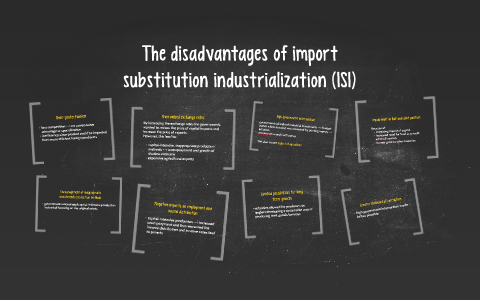Import substitution is a policy that aims to reduce a country's reliance on imported goods by promoting domestic production of those goods. This policy has a number of advantages that can benefit both the domestic economy and the population as a whole.
One of the main advantages of import substitution is that it can help to stimulate domestic economic growth. When domestic producers are able to meet the demand for goods previously imported from other countries, they can increase their production and sales, leading to increased profits and potentially hiring more workers. This can lead to a positive cycle of economic growth and development.
Import substitution can also help to create jobs and improve income distribution within a country. By increasing domestic production, import substitution can create employment opportunities for workers in the domestic manufacturing sector. This can help to reduce unemployment and improve income distribution, as more people have the opportunity to earn a living wage.
In addition, import substitution can help to improve the balance of trade for a country. By reducing the amount of imported goods, a country can decrease the amount of money it is spending on imports, leading to a reduction in its trade deficit. This can help to improve the overall economic stability of the country and make it less vulnerable to external economic shocks.
Another advantage of import substitution is that it can help to increase the domestic supply of essential goods and services. In some cases, a country may rely heavily on imports for certain essential goods and services, such as food or medical supplies. By promoting domestic production of these goods, a country can increase its domestic supply and reduce its reliance on imports, helping to ensure that these essential goods and services are available to the population.
Finally, import substitution can help to increase the resilience of a country's economy. By promoting domestic production and reducing reliance on imports, a country can become less vulnerable to external economic shocks, such as changes in global trade patterns or fluctuations in exchange rates. This can help to ensure that the country's economy remains stable and strong even in times of economic uncertainty.
Overall, import substitution has a number of advantages that can benefit both the domestic economy and the population as a whole. By promoting domestic production and reducing reliance on imports, a country can stimulate economic growth, create jobs, improve income distribution, improve the balance of trade, increase the domestic supply of essential goods and services, and increase the resilience of its economy.
The Benefits and Limitations of Import Substitution

Some African countries have signaled that they support this concept, while others promote domestic manufacturing and exclude imports. The disadvantages of most flotation techniques are that the walls of eggs and cysts will often collapse, thus hindering identification. For example, Alexander Hamilton used tariffs to promote domestic manufacturing while simultaneously reducing British reliance. How is import substitution beneficial for our country? Seeing their economy in crisis , the European nations decided to minimize the purchase of imported goods or rate them with high tariffs. What is import substitution industry? What is the difference between import substitution and export orientation? In such a case, this hinders production and growth, bringing the collapse of the same industries. Furthermore, restrictions such as import licenses, security deposits, and tariff barriers hamper trade between countries.
What are the advantages and disadvantages of substitution cipher?

What are the disadvantages of sedimentation techniques? Sometimes international markets are flooded with products that are both affordable and quality. Countries such as Argentina, Brazil, Chile, Mexico, and Uruguay were successful in adopting ISI due to their investment in technology and meticulous planning. However, an imbalance due to excessive dependence on imports is detrimental to a country's economy. What are the objectives of Import substitution industrialization? The import substitution is most common in developing countries that aim to be a self-sufficient economy. Why is ISI failing? For example, consumers can purchase goods and services produced in their own country rather than having to pay high prices elsewhere. But by 1980, it was rejected by all. How does import substitution benefit the economy? Import substitution industrialization ISI was pursued mainly from the 1930s through the 1960s in Latin America—particularly in Brazil, Argentina, and Mexico—and in some parts of Asia and Africa.
HRS blog.sigma-systems.com

Import substitution industrialization ISI is a theory of economics typically adhered to by developing countries or emerging market nations that seek to decrease their dependence on developed countries. Import substitution in Pakistan is a recent example. Which countries used import substitution? What are the advantages of import substitution? Since South Korea was able to replicate the Japanese model for development, with minor adjustments, this means other countries have the opportunity to achieve massive growth rates with further adjustments to be compatible with both their culture and economic Advantages And Disadvantages Of Global Trade And International Trade 998 Words 4 Pages International trade is also knows as a globe trade which give the country opportunity to expands their markets for both good and services that otherwise may not have been available in other countries. In Latin America, the ECLA report became a founding document of structuralism and a virtual manual for import-substitution industrialization. Although results varied from country to country, general trends included production that often did not extend into industries other than consumer goods, slow employment growth, agricultural-sector decline, and minimal productivity growth. However, the policy lost its momentum in the latter half of the century.
:max_bytes(150000):strip_icc()/GettyImages-968819844-f084399962054d939aff07fd3946132e.jpg)






